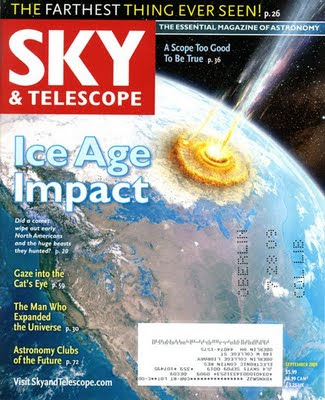 The July issue of Sky & Telescope just arrived, in time for the last few days of July's theme: Celebrate Astronomy! as part of the Year of Science. The cover, by S&T artist Casey Reed, is sure to draw you in, illustrating the question "Did a comet wipe out early North Americans and the huge beasts they hunted?" How can you resist such a provocative query? "Demise of the megabeasts" indeed - and what role was played by the Clovis people thought to be in North America at the time? Those "ice age big game hunters" were sophisticated predators, notes Paul Martin of the University of Arizona.
The July issue of Sky & Telescope just arrived, in time for the last few days of July's theme: Celebrate Astronomy! as part of the Year of Science. The cover, by S&T artist Casey Reed, is sure to draw you in, illustrating the question "Did a comet wipe out early North Americans and the huge beasts they hunted?" How can you resist such a provocative query? "Demise of the megabeasts" indeed - and what role was played by the Clovis people thought to be in North America at the time? Those "ice age big game hunters" were sophisticated predators, notes Paul Martin of the University of Arizona. Science is so fascinating when astronomy, geology, paleontology and anthropology mesh together like reading a good mystery or detective story.
The article, Ice Age Impact, was written by Ivan Semeniuk. Listen to a podcast of scientists who were interviewed for the article at SkyandTelescope.com/iceageimpact.


